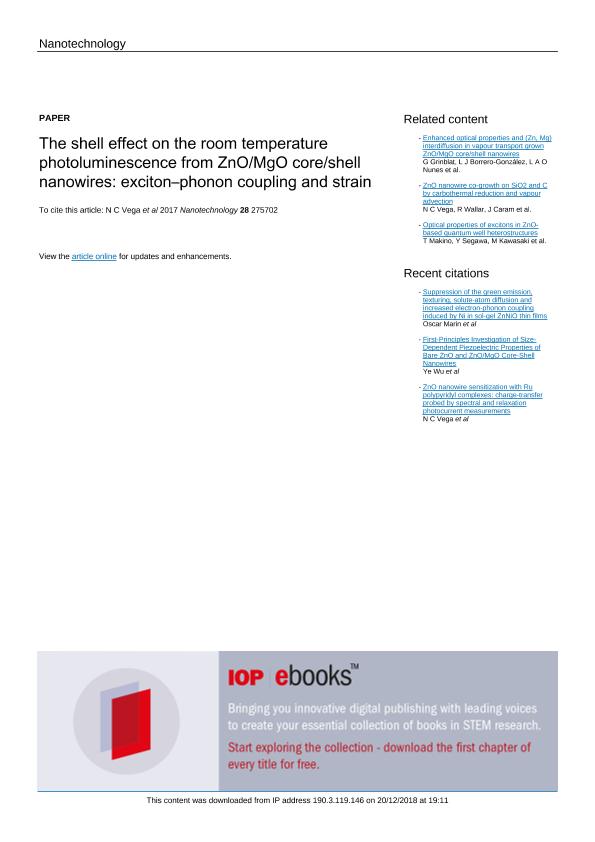Mostrar el registro sencillo del ítem
dc.contributor.author
Vega, Nadia Celeste

dc.contributor.author
Marín Ramírez, Oscar Alonso

dc.contributor.author
Tosi, Ezequiel

dc.contributor.author
Grinblat, G.
dc.contributor.author
Mosquera, E.
dc.contributor.author
Moreno, M. S.
dc.contributor.author
Tirado, Monica Cecilia

dc.contributor.author
Comedi, David Mario

dc.date.available
2019-01-03T13:59:25Z
dc.date.issued
2017-06
dc.identifier.citation
Vega, Nadia Celeste; Marín Ramírez, Oscar Alonso; Tosi, Ezequiel; Grinblat, G.; Mosquera, E.; et al.; The shell effect on the room temperature photoluminescence from ZnO/MgO core/shell nanowires: Exciton-phonon coupling and strain; IOP Publishing; Nanotechnology; 28; 27; 6-2017; 1-10
dc.identifier.issn
0957-4484
dc.identifier.uri
http://hdl.handle.net/11336/67273
dc.description.abstract
The room temperature photoluminescence from ZnO/MgO core/shell nanowires (NWs) grown by a simple two-step vapor transport method was studied for various MgO shell widths (w). Two distinct effects induced by the MgO shell were clearly identified. The first one, related to the ZnO/MgO interface formation, is evidenced by strong enhancements of the zero-phonon and first phonon replica of the excitonic emission, which are accompanied by a total suppression of its second phonon replica. This effect can be explained by the reduction of the band bending within the ZnO NW core that follows the removal of atmospheric adsorbates and associated surface traps during the MgO growth process on one hand, and a reduced exciton-phonon coupling as a result of the mechanical stabilization of the outermost ZnO NW monolayers by the MgO shell on the other hand. The second effect is the gradual increase of the excitonic emission and decrease in the defect related emission by up to two and one orders of magnitude, respectively, when w is increased in the ∼3-17 nm range. Uniaxial strain build-up within the ZnO NW core with increasing w, as detected by x-ray diffraction measurements, and photocarrier tunneling escape from the ZnO core through the MgO shell enabled by defect-states are proposed as possible mechanisms involved in this effect. These findings are expected to be of key significance for the efficient design and fabrication of ZnO/MgO NW heterostructures and devices.
dc.format
application/pdf
dc.language.iso
eng
dc.publisher
IOP Publishing

dc.rights
info:eu-repo/semantics/openAccess
dc.rights.uri
https://creativecommons.org/licenses/by-nc-sa/2.5/ar/
dc.subject
Strain
dc.subject
Zno Exciton-Phonon Coupling
dc.subject
Zno Nanowires
dc.subject
Zno Pholuminescence
dc.subject
Zno/Mgo Core/Shell
dc.subject.classification
Astronomía

dc.subject.classification
Ciencias Físicas

dc.subject.classification
CIENCIAS NATURALES Y EXACTAS

dc.title
The shell effect on the room temperature photoluminescence from ZnO/MgO core/shell nanowires: Exciton-phonon coupling and strain
dc.type
info:eu-repo/semantics/article
dc.type
info:ar-repo/semantics/artículo
dc.type
info:eu-repo/semantics/publishedVersion
dc.date.updated
2018-12-19T14:41:52Z
dc.journal.volume
28
dc.journal.number
27
dc.journal.pagination
1-10
dc.journal.pais
Reino Unido

dc.journal.ciudad
Londres
dc.description.fil
Fil: Vega, Nadia Celeste. Universidad Nacional de Tucumán. Facultad de Ciencias Exactas y Tecnología. Departamento de Física. Laboratorio de Física del Sólido; Argentina. Consejo Nacional de Investigaciones Científicas y Técnicas. Centro Científico Tecnológico Conicet - Tucumán; Argentina
dc.description.fil
Fil: Marín Ramírez, Oscar Alonso. Universidad Nacional de Tucumán. Facultad de Ciencias Exactas y Tecnología. Departamento de Física. Laboratorio de Física del Sólido; Argentina. Consejo Nacional de Investigaciones Científicas y Técnicas. Centro Científico Tecnológico Conicet - Tucumán; Argentina. Universidad de Chile; Chile
dc.description.fil
Fil: Tosi, Ezequiel. Universidad Nacional de Tucumán. Facultad de Ciencias Exactas y Tecnología. Departamento de Física. Laboratorio de Física del Sólido; Argentina. Consejo Nacional de Investigaciones Científicas y Técnicas. Centro Científico Tecnológico Conicet - Tucumán; Argentina
dc.description.fil
Fil: Grinblat, G.. Universidad Nacional de Tucumán. Facultad de Ciencias Exactas y Tecnología. Departamento de Física; Argentina. Universidad Nacional de Tucumán. Facultad de Ciencias Exactas y Tecnología. Departamento de Física; Argentina
dc.description.fil
Fil: Mosquera, E.. Universidad de Chile. Facultad de Ciencias Físicas y Matemáticas. Departamento de Geología; Chile
dc.description.fil
Fil: Moreno, M. S.. Comisión Nacional de Energía Atómica. Gerencia del Area de Investigación y Aplicaciones No Nucleares. Gerencia de Física (Centro Atómico Bariloche); Argentina
dc.description.fil
Fil: Tirado, Monica Cecilia. Universidad Nacional de Tucumán. Facultad de Ciencias Exactas y Tecnología. Departamento de Física; Argentina. Consejo Nacional de Investigaciones Científicas y Técnicas. Centro Científico Tecnológico Conicet - Tucumán; Argentina
dc.description.fil
Fil: Comedi, David Mario. Consejo Nacional de Investigaciones Científicas y Técnicas. Centro Científico Tecnológico Conicet - Tucumán; Argentina. Universidad Nacional de Tucumán. Facultad de Ciencias Exactas y Tecnología. Departamento de Física. Laboratorio de Física del Sólido; Argentina
dc.journal.title
Nanotechnology

dc.relation.alternativeid
info:eu-repo/semantics/altIdentifier/url/http://stacks.iop.org/0957-4484/28/i=27/a=275702?key=crossref.3f67baf6994dee76e362cb399fd76f47
dc.relation.alternativeid
info:eu-repo/semantics/altIdentifier/doi/https://doi.org/10.1088/1361-6528/aa7454
Archivos asociados
